AVOID
• Certain antibiotics, including aminoglycosides, gentamicin, and tobramicin, which can cause hearing loss. Consult your physician.

• Aspirin, as it can cause tinnitus.

• Some diuretics, such as furosemide (Lasix), in high doses and some anti-hypertensive drugs, such as the combination bisoprolol and hydro-chlorothiazide (Ziac), which can cause hearing loss. Consult your physician.

• Exposure to loud noise, and turn down ambient noises.

• Alcohol use and smoking, which speed up hearing decline and promote plaque buildup, preventing proper nourishment of the ears.
ROSACEA
ROSACEA, OR ACNE ROSACEA, IS A CHRONIC ACNE CONDITION. It affects the forehead, nose, cheeks, and sometimes the chin, and it occurs mainly in people with light skin and of northwestern European descent. The exact cause of rosacea is unknown, though genetics are thought to play a role. Diet and lifestyle are key contributors as well. Recent research suggests that parasitic mites, known as demodex mites, are more abundant in people with rosacea. (Demodex mites are also thought to cause some severe cases of acne.) In severe cases, untreated rosacea may be disfiguring to the face. Many well-documented triggers have been identified, including extreme weather and temperature exposure, excessive sunlight or sunburn, alcohol, caffeine, spicy foods, and certain medications. Topical steroid use can also trigger an outbreak. Western medicine offers a variety of palliative treatments, including antibiotics, creams, and light therapy involving broad spectrum pulsed-light therapy.
In Chinese medicine, flushing of the face has many causes, and several organ networks may be involved. The skin is governed by the lung network, so heat in the lungs will affect the quality of the skin. Too much alcohol or rich and spicy foods creates excess heat in the stomach network, which can end up on the face as rosacea. Emotion also shows itself in the face. Stress and anxiety can flare up the fire energy of the heart, which governs the spirit, causing rosacea. My treatment for rosacea focuses on soothing and calming the spirit, clearing heat, and removing any circulation blockages through acupuncture, herbal therapy, and lifestyle and dietary changes.
Here are some of my recommendations.
DIET
• Foods play a major role in triggering rosacea. Your diet should be on the bland side, with a healthy mix of whole grains, green leafy vegetables, and fresh fruits. Identifying and avoiding triggers can dramatically reduce your symptoms. Incorporate more prunes, guava, pearl barley, water chestnuts, lotus seeds (cook like beans), lotus leaves, mulberries, goji berries, cucumbers, beets, beet tops, dandelion greens, squash, and mung beans into your diet. Omega-3 fatty acids, found in cold-water fish, can help nourish the skin. Water is essential for cleansing the body, so drink at least 60 ounces a day.

• Eliminate processed foods, foods containing artificial additives, simple sugar and bleached flour, soft drinks, and spicy, fried, and oily foods. Animal proteins should be avoided. Excessive sun exposure should also be avoided. Alcohol, especially red wine, and aged cheeses, are notorious for triggering the condition.
HOME REMEDIES
• Shave the skin of one fresh cucumber, put it in a blender, and puree with 1 egg white. Apply with cotton ball to the affected area and leave on for 30 minutes, then wash with cold water. Repeat daily.

• Make chamomile tea and soak the affected area using a clean soft gauze, changing the application every 15 minutes. Repeat twice a day.

• Take 1 tablespoon flaxseed oil or fish oil daily; you can use it in a salad as a dressing.
DAILY SUPPLEMENTS
• Taking vitamin B complex and pancreatic and digestive enzymes can help reduce rosacea.

• Topical application of vitamin A (5,000 IU), often used for acne, can help with the inflammation of rosacea.

• Taking betaine hydrochloride (300 milligrams) at mealtimes aids stomach acid production and may be helpful, as some people with rosacea do not produce sufficient stomach acid.
HERBAL THERAPY
• Herbs can be found in health food or vitamin stores, online, and at the offices of Chinese medicine practitioners. Herbs should be used according to individual needs; consult with a licensed practitioner for a customized formulation. To learn more about the herbs listed here, go to www.askdrmao.com.

• Burdock, yellow dock, red clover, and cleavers are used to relieve symptoms of rosacea.

• Chinese medicine herbal prescriptions for rosacea include the herbs pagoda tree flower, skullcap, coptidis, cape jasmine fruit, rehmannia, peony, and cardamom.

• Our Exquisite Skin Chinese herbal formula helps support healthy skin function and reduce itching. It contains siler, caltrop, schizonepetae, astragalus, peony, dong quai, Fo-Ti, rhubarb, and licorice.
EXERCISE
Stress and anxiety can trigger and worsen rosacea. Tai chi and qi gong are great for reducing stress and calming the emotions, and they are also physically beneficial. A qi gong meditation called Heart Nourishing Qi Gong helps calm anxiety, reduce stress, promote healthy circulation, and relieve symptoms.
Inhale, and from the sides of your body, gently raise your arms to your head with your palms facing up. When you reach your head, turn your palms so that they face the top of the head at the acupoint Hundred Meeting (DU-20).
Exhale, imagining that you are exhaling through the centers of your palm (at the Labor Palace acupoint) into the top of your head.
Inhale, and then exhale, gently bringing your arms down with your palms facing down. At about head level, start exhaling out of the middle of your palms. Visualize bringing the energy down through your lower abdomen. End by turning your palms so that they face your abdomen.
At this point, your arms should be curved and relaxed at about waist level. Hold this posture, gently breathe, and meditate.
Inhale, and bring the energy up from your perineum to the top of your upper back just below the cervical vertebrae (the vertebrae in your neck).
Exhale, imagining you are exhaling down the inside of your left arm, out of the Labor Palace point, and into your lower abdomen.
Inhale from the middle of your palms and bring the energy up your left arm, to the center of your chest.
Exhale, and visualize the energy moving down and around your lower abdomen, starting down your right side and finishing up around your left side.
Inhale, and bring the energy up from your perineum to the top of your upper back just below the cervical vertebrae.
Exhale down your right arm, out of the middle of your palms and into the lower abdomen.
Inhale from the middle of your palms and bring the energy up your right arm to the center of your chest.
Exhale, and visualize the energy moving down and around your lower abdomen, starting down your left side and finishing up around your right side.
Inhale from the center of your left sole, bringing the energy up your left leg, to your thigh, and then your hip.
Exhale, and visualize the energy moving around your abdomen, starting up your lower left side, to the top of the abdomen, down your right side and ending up around the left side of your lower abdomen.
Inhale from the center of your right sole, bringing the energy up your right leg, to your thigh, and up to your hip.
Exhale, and visualize the energy moving around your lower abdomen, starting from your right side, to the top, down your left side, and ending up the right side of your lower abdomen.
Inhale, and visualize the energy at the the top of the head moving down to the center of your chest.
Exhale, and visualize the energy moving around your lower abdomen, starting up the top, moving down your left side, and ending up at the right side of your lower abdomen.
Begin to return the qi to your body.
Inhale, bringing your hands to your sides. Then with your palms facing toward your back, gather the energy around you (making a circle), bringing your arms in front of you, with your palms facing your lower abdomen.
Exhale, visualizing the gathered energy entering your lower abdomen and swirling around the navel.
Quickly inhale, and slowly raise your hands with your palms facing down and level with your lower abdomen.
Exhale, and bring the energy back to your lower abdomen.
Repeat this exercise twice a day. In evening, do this exercise before 7 p.m.
ACUPRESSURE
• Find the acupoint Inner Gate (P-6), three finger-widths above the wrist crease, between the two tendons on the inside of the left forearm. Apply moderate pressure with your right thumb. Hold for 3 minutes. Repeat on the right arm.

• Find the acupoint Foot Three Miles (ST-36), four finger-widths below the kneecap on the right leg. Apply moderate pressure with your right thumb until you feel soreness. Hold for 5 minutes. Repeat on the left leg.
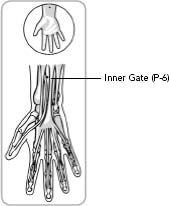
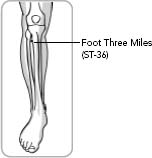
AVOID
• Exposure to temperature changes, cold or hot water, and detergents.

• Exposure to sunlight UVA rays, which can trigger an outbreak.

• Excessive use of cosmetics, creams, and abrasive skin cleansers.

• Alcohol, smoking, and caffeine, which are irritants and generate heat that contributes to flare-ups.

• Stress, anxiety, and emotional upset, which can initiate flare-ups.
SCIATICA
THE LARGEST NERVE BUNDLE IN YOUR BODY can become the largest pain in the rear. The sciatic nerve originates from the lowest part of your spine and serves the lower body. When the nerve gets irritated, inflamed, or compressed, unbearable pain shoots down your buttocks, to the back of your legs, and down to your feet. You may also experience numbness in the leg or feet, difficulty walking or standing, or even bladder problems and fever. Anything from prolonged sitting on hard surfaces to carrying a large wallet can cause sciatica. Herniated disks, muscular pressure, and spinal stenosis (narrowing of the space in the spinal column through which the nerve extends) are possible causes as well. Sciatica mostly affects people ages twenty-five to forty-five, most often the result of sudden twisting movements or the improper lifting of heavy objects. The easiest preventives for sciatica are proper posture, good physical fitness, taking special care when lifting or moving heavy objects, and a healthy lifestyle in general.
There is a condition in Chinese medicine known as painful obstruction syndrome, which describes a situation in which the energy meridians and blood vessels become compressed, blocking the flow of energy and blood and causing severe pain. Sciatica is one such painful obstruction syndrome, often caused by dampness in addition to energy and blood constriction. In Chinese medicine, there are further differentiations of dampness-related painful obstruction, such as dampness and cold, dampness and wind, and dampness and heat classifications. See the section on arthritis (pages 195–202) for recommendations for each of these. I’ve treated many acute and chronic sciatica conditions using acupuncture and herbal therapy with good results. Acupuncture is effective for all kinds of pain, but particularly for sciatica. My approach is to unblock the stagnation, promoting the flow of energy and blood. I also advise my patients on exercises to strengthen the core muscles.
Here are some of my recommendations.
DIET
• A healthy, well-balanced diet rich in complex carbohydrates, whole grains, fresh vegetables, and organic animal protein is important for a healthy body. I recommend foods high in potassium, including bananas, potatoes, oranges, spirulina, and chlorella, as well as dark green leafy vegetables, and saltwater fish such as flounder, salmon, and sardines. Soybeans, kidney beans, black beans, garlic, onions, kale, grapes, mulberries, anise seeds, cinnamon, almonds, walnuts, and prunes are also beneficial.

• Avoid alcohol and smoking, as they can irritate the sciatic nerve. Sugar, especially processed bleached sugar, should be eliminated. Irritating foods such as spicy, greasy, or fried foods, as well as dairy and other foods that create dampness, should also be avoided.
HOME REMEDIES
• Chamomile tea is a muscle relaxant, and can help alleviate the pain of sciatica. Steep chamomile tea bags in boiling water for 5 minutes. Drink 3 cups daily.

• Prepare a shallow bath with lukewarm water (about body temperature), add 1 cup Epsom salts, 2 tablespoons eucalyptus oil, and a few drops of lavender and chamomile oils. Sit in the bath for 20 minutes to relax your body, then take a lukewarm shower. Take a bath twice daily until the pain is substantially relieved.
DAILY SUPPLEMENTS
• Taking vitamin B complex can speed up healing in sciatica conditions.

• Taking calcium (2,000 milligrams) and magnesium (1,000 milligrams) helps relieve muscle spasms and reduce pressure on the nerves.

• The enzyme bromelain (800 milligrams) is an natural anti-inflammatory and helps alleviate back pain.

• MSM (2,000 milligrams) is also useful for general pain relief.
HERBAL THERAPY
• Herbs can be found in health food or vitamin stores, online, and at the offices of Chinese medicine practitioners. Herbs should be used according to individual needs; consult with a licensed practitioner for a customized formulation. To learn more about the herbs listed here, go to www.askdrmao.com.

• Evening primrose oil, horsetail, and chamomile are good Western herbs used to treat sciatica.

• White willow bark, valerian, and passionflower work as relaxants and are natural pain relievers.

• Chinese herbal formulations for sciatica includes the herbs gentiana root, cnidium, peach kernel, safflower, licorice, notopterygium root, myrrh, angelica, dong quai, pteropus, nutgrass, achyranthes, and other Chinese herbs.
EXERCISE
There is a definite advantage to exercising regularly, as exercise tones and strengthens your muscles and helps maintain healthy joints. Exercise can also help prevent sciatica. During sciatica flare-ups, pain may preclude you from exercising and bed rest can help reduce the irritation of the nerve. In addition to cardiovascular exercise such as swimming or walking for 30 minutes a day, yoga, tai chi, and qi gong can help strengthen the body without causing too much stress.
I recommend Dao In Qi Gong, which is gentle on the body and provides great benefits. The sequence Stretching the Well helps the sciatic nerve. Practice this regularly to attain relief and prevent flare-ups.
Sit with your right leg as when cross-legged and your left leg turned out to the left so your left heel is touching your left buttock. Hold your left ankle with your left hand and hold your right heel with your right hand.
Inhale, and turn your head to the right, twist your torso to the right, and lean to the right, still holding on to your heel.
Exhale, and twist your head and upper body to the left, lowering your body and bringing your right shoulder to your right knee, still holding your ankle.
Inhale, lift yourself up, and twist to the left, looking behind you.
Exhale, and return to the beginning posture.
Repeat the steps above for a total of 3 times on this side.
Then switch sides: Sit with your left leg as when cross-legged and your right leg turned out to the right so your right heel is touching your right buttock. Hold your right ankle with your right hand and hold your left heel with your left hand.
Inhale, and turn your head to the left, twist your torso to the left, and lean to the left, still holding your heel.
Exhale, and twist your head and upper body to the right, and lowering your body and bringing your left shoulder to your left knee, still holding your ankle.
Inhale, lift yourself up, and twist to the right, looking behind you.
Exhale, and return to the beginning posture.
Repeat the steps above for a total of 3 times on this side.
ACUPRESSURE
• Find the acupoint Jumping Circle (GB-30), on the center of the buttocks about midway between the tip of the coccyx and the right hipbone. Apply heavy pressure with your right thumb or index finger until you feel soreness. Hold for 30 seconds and release. Repeat several times, alternating the right and left sides.

• Find the acupoint Yang Spring (GB-34), on the outer part of the lower right leg, just below the bony structure located near the end of the knee crease about four finger-widths below the kneecap. Apply steady pressure with your right thumb until you feel soreness. Hold for 3 minutes. Repeat on the left leg.

• Engaging the combination of these points is excellent for relaxing and strengthening the tendons and treating sciatica.
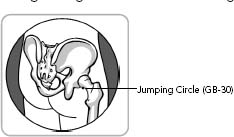
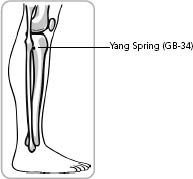
AVOID
• Smoking and excessive use of alcohol, as they can deplete the body of vital nutrients needed for bone health. Nicotine especially irritates the sciatic nerve.

• The insomnia drug Ambien, which has been linked to sciatica in some people. Consult your physician for alternatives.

• Stress, worry, and tension, as these emotions irritate the nervous system and predispose you to sciatica.

• Poor posture—always sit with your back erect with support in the lumbar area. Do not sit for prolonged periods on hard surfaces. If you carry a wallet, take it out of your rear pocket when sitting. Take frequent breaks at work and stretch your lower back and buttocks.
SINUS PROBLEMS
SINUS PROBLEMS CAN INCLUDE A SLEW OF CONDITIONS related to the nasal passageway and the cavities beyond it. Acute or chronic sinus infections or sinusitis, affect some 37 million people in the United States. In a sinus infection, the mucous linings of the sinuses are inflamed. Causes include bacterial, viral, and fungal infections. Allergies, polyps, and a deviated septum can also contribute to sinus problems including nasal congestion. Allergic rhinitis is a result of the immune system’s overreaction to allergens in the air; it often occurs during the spring and is commonly known as hay fever. Symptoms of sinusitis include nasal congestion, postnasal drip, facial pain, headaches, fever, tiredness, thick green or yellow discharge, and a feeling of facial fullness that gets worse when bending forward. During a severe sinus infection some people get toothaches. In chronic cases, the sense of smell can be diminished.
In Chinese medicine, the nose and sinuses are directly linked to the lung–large intestine network and the spleen-pancreas-stomach network. Invasion by pathogens or foreign particles causes clogging of the lung network and leads to nasal congestion and heat signs that include inflammation or infection. The digestive system is involved in providing proper nourishment and supporting the immune system. A weak digestive system can produce dampness that further congests the upper respiratory tract with mucus. In my clinical experience, strengthening the digestive system is fundamental to long-term relief of all sinus problems. Only with strong digestive function can there be a healthy immune system. I use acupuncture for immediate symptomatic relief and herbal therapy to clear the pathogens. I also recommend special breathing exercises, and I educate patients about an appropriate diet. Here are some of my favorite remedies.
DIET
• A wholesome, balanced diet with a high concentration of fiber and complex carbohydrates can help improve and maintain good respiratory health. Incorporate lots of whole grains, including quinoa, amaranth, and brown rice rather than wheat, rye, and barley, which are typically high-allergy grains. Favor papaya, cranberries, pears, pineapples, wild cherries, mangoes, and citrus fruits such as grapefruit and limes, cauliflower, and green vegetables such as artichokes, Brussels sprouts, broccoli, kale, and spinach. Herbs and spices such as ginger, scallions, basil, garlic, oregano, cayenne pepper, white pepper, horseradish, and turmeric also help to fight inflammation and help open passageways. Drink 8 glasses of warm or hot water a day.

• Foods that produce mucus and dampness, including dairy products, cold and raw foods, wine, greasy foods, and simple sugars, should be avoided. Soft drinks and some store-bought juices have a high content of corn syrup, which also produces dampness and mucus.
HOME REMEDIES
• Add a few drops of oil of wintergreen or menthol to a vaporizer. Inhale the vapor through your nose until the passageways clear. If you don’t own a vaporizer, simply drop the oil into a pot of boiling water and inhale the steam with a towel covering your head and the pot, being careful not to burn yourself with the steam vapor.

• Make a tea by boiling 2 ounces magnolia flowers, 1 teaspoon chopped basil, 2 slices of ginger, and 1 chopped scallion in 3 1/2 cups of water for 20 minutes. Strain, and drink 1 cup 3 times a day for 1 week, or until the condition clears up.

• Mix 1 pressed garlic clove with 1 teaspoon olive oil and soak 2 clean cotton balls with the mixture. Wash your nostrils with warm salt water, then place the cotton balls in your nostrils. Leave in for 20 minutes; repeat 3 times a day until the symptoms clear up.

• Irrigate your nasal passageways with a solution of 1 teaspoon sea salt and 1 drop each of oregano oil and wintergreen oil in a cup of warm water. Fill a small squeeze bottle with the solution, and squirt it into one nostril at a time, and blow out through the nose. Alternate nostrils until you use up the solution. Repeat daily.
DAILY SUPPLEMENTS
• Supplementing with vitamins A (200 IU) and C (1,000 milligrams) can help ward off infections and regulate immune response. Zinc (50 milligrams) also helps supports a healthy immune system and prevents infections.

• Taking bromelain (500 milligrams) and quercetin (400 milligrams) can reduce histamine release, the body’s natural allergic response.

• Gamma-linolenic acid (GLA; 450 milligrams) contains omega-6 fatty acids, which regulate inflammatory response.
HERBAL THERAPY
• Herbs can be found in health food or vitamin stores, online, and at the offices of Chinese medicine practitioners. Herbs should be used according to individual needs; consult with a licensed practitioner for a customized formulation. To learn more about the herbs listed here, go to www.askdrmao.com.

• Ginger and licorice root are used to reduce inflammation and fight off allergies.

• Elderberry and astragalus are immune moderators and are useful in fighting upper respiratory infections and allergies.

• Magnolia flowers, mint, angelica, platycodon, dandelion, xanthium fruit, perilla seeds, and siler root all have anti-allergic properties and help reduce nasal inflammation and congestion.

• Traditional Chinese herbs used to strengthen the digestive system and support a healthy immune system include ligustrum, atractylodis, oryza, Cherokee rosehip, mulberry, honeysuckle, self-heal spike, Fo-Ti and eclipta.
EXERCISE
Exercise strengthens the body against infections and illnesses, and it helps balance immune function. Daily 30-minute cardiovascular exercise such as brisk walks (2 to 3 miles per hour) or aerobic workouts can help improve circulation and strengthen the body. I also recommend two Dao In Qi Gong exercises, Immortal Pressing the Sun and Moon Corners, and Immortal Massaging the Nose, simple yet effective exercises for relieving sinus congestion.
For Immortal Pressing the Sun and Moon Corners, sit at the tip of a sturdy chair with your back erect, spine stretched, and your head tilted slightly forward.
Inhaling, press your forehead just inside the temples with your palms.
Exhale, and release.
Repeat for a total of 3 times.
For Immortal Massaging the Nose, sit at the tip of a sturdy chair with your back erect, spine stretched, and your head tilted slightly forward.
Cross your middle and index fingers by placing the tips of your middle fingers on top of the fingernails of your index fingers.
Rub the sides of your nose 36 times in a circular motion, warming your fingers first if they’re cold. You can apply a small amount of peppermint or spearmint essential oils to the area to enhance the massage.
ACUPRESSURE
• Find the acupoint Valley of Harmony (LI-4), at the web between your right thumb and index finger. Apply steady pressure with your left thumb until you feel soreness. Hold for 2 minutes. Repeat on the left hand.

• Locate the acupoint Welcome Fragrance (LI-20), on either side of the nostrils, next to the nose flap. Using the fingertips or the nails of your index fingers, gently press and dig in until you feel soreness. Hold the pressure for 2 minutes. Repeat as needed to clear nasal congestion.
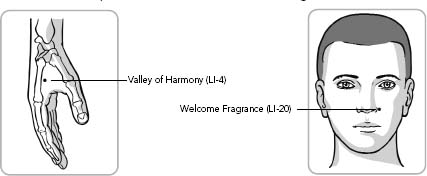
AVOID
• Extreme temperature and weather fluctuations, as any sudden changes will worsen the condition. Air conditioners and heaters are particularly bad offenders.

• Exposure to environmental triggers, including dusty, dirty, and polluted air, which aggravate the nasal passages.

• Stress, and get plenty of sleep. Sinus congestion is often worse with lack of sleep and rest.

• Alcohol and smoking, both of which are irritating to the respiratory tract and make inflammation worse.
SNORING
MORE THAN 40 MILLION AMERICANS SNORE AT NIGHT. In itself, snoring is not a serious condition, but it can affect your quality of sleep and can be very disturbing to your loved ones. Snoring affects more men than women. There are severe types of snoring that are associated with sleep disorders such as sleep apnea, a condition in which a person may stop breathing for as long as ninety seconds. Symptoms of snoring include the wheezing, gurgling, and snorting noises made by the soft palate as air is forced through the oral and nasal cavity at high speeds. The vibration of the soft palate produces these sounds. Obesity plays a major role in snoring. Losing just 5 percent of body weight can reduce snoring dramatically and help improve quality of sleep. Asthma is one the most common medical conditions that can cause snoring. Smoking, alcohol use, and poor diet can also instigate snoring. Western medicine offers a variety of mechanical and surgical solutions to the problem. One treatment involves radio frequency tissue ablation—a surgical technique for cutting away the flap of skin at the uvula in the back of the throat. When left untreated, people who snore are at higher risk for high blood pressure, heart disease, and stroke.
In Chinese medicine, snoring is considered energy stagnation. The most common underlying cause of the stagnation is a buildup of dampness and phlegm. Dampness in the body is the direct result of improper diet, which weakens spleen and digestive functions and impairs the body’s ability to transform and transport vital nutrients. Residue then lingers in the body and forms dampness, impairing cellular function, congealing into phlegm, and obstructing flow.
Excess dampness and mucus also translate into obesity. I had a patient who came in for a chronic sinus condition and a weight problem. It took three to four months of acupuncture to clear his nasal passageways and herbal therapy to eliminate mucus and mobilize the metabolic fire. I recently saw his wife, who thanked me for getting rid of her husband’s snoring problem. By taking care of his sinus condition and helping him lose weight, the acupuncture also helped his snoring disappear. It is imperative to establish good dietary and lifestyle habits to prevent a buildup of dampness and energy blockage. Here are some simple recommendations I give to my patients.
DIET
• A wholesome, seasonally balanced diet rich in soluble fiber and complex carbohydrates can help maintain good respiratory health and vitality of defensive qi. Incorporate more whole grains (including quinoa, brown rice, and millet), cabbage, beets, beet tops, carrots, and yams, into your diet. Papaya, cranberries, pears, pineapple, wild cherries, mangoes, and citrus fruits, such as grapefruit and limes, are also helpful. Green leafy vegetables including spinach, broccoli, and kale provide essential nutrients for healthy immunity. Ginger, onions, basil, garlic, bamboo shoots, black mushrooms, dandelion greens, and chrysanthemum flowers also help fight inflammation.

• Drink 80 ounces of hot or warm water a day—that’s ten 8-ounce glasses. Water intake is essential for proper lymphatic drainage. All vegetables need to be thoroughly washed in running water to remove any pesticide and chemical residues.

• Foods that produce mucus and dampness, including dairy products, cold and raw foods, greasy foods, white sugar, and bleached flour, should be avoided. Wheat, chocolate, shellfish, potatoes, tomatoes, and eggplant may overstimulate the immune response and should be eaten in moderation. Soft drinks and some packaged fruit juices have a high content of corn syrup and produce dampness and mucus.
HOME REMEDIES
• Practice good sleeping habits. Clear your airways and nasal passages before going to bed. Sleep on your right side rather than on your back to reduce, if not eliminate, snoring. Pillows should not be too thick to avoid kinking your neck and obstructing the airways.

• Gargle with warm salt water before going to bed to shrink the tissues, moisten the oral cavity, and prevent dryness.

• Drink green tea and chamomile tea—they contain natural antihistamines and can help reduce mucus production and balance the immune system.
DAILY SUPPLEMENTS
• Chromium (200 micrograms) and essential fatty acids found in fish and flaxseed oils (1,000 milligrams EPA; 800 milligrams DHA) can help with inflammatory conditions and reduce tissue swelling. Chromium is also good for reducing blood sugar, a form of dampness.

• Probiotics (3 to 5 billion organisms), with their beneficial organisms for intestinal flora are essential for protecting against allergic reactions.

• Bromelain (450 milligrams) and the antioxidant quercetin (500 milligrams) can work to modulate histamine release, which causes allergic response.
HERBAL THERAPY
• Herbs can be found in health food or vitamin stores, online, and at the offices of Chinese medicine practitioners. Herbs should be used according to individual needs; consult with a licensed practitioner for a customized formulation. To learn more about the herbs listed here, go to www.askdrmao.com.

• Drink ginger and peppermint tea at night before bedtime to reduce swelling and keep the sinus passageways open.

• Unripe orange, tangerine, and lemon peels are good for digestion and reduce dampness and mucus.

• Our family formula Allergy Tamer is made up of herbs including magnolia flowers, xanthium, mint, dandelion, Chinese basil, siler root, schizandra, and other herbs that support healthy immune function and relieve allergic reactions.
EXERCISE
Physical activity helps maintain good digestion, helps you lose weight and maintain a healthy body weight, and also helps reduce stress, anxiety, and strong emotions. A daily fitness program consisting of 30-minute walks and qi gong or tai chi is very beneficial for a healthy digestive system and can help treat snoring.
The following two Dao In Qi Gong exercises, Immortal Pressing the Sun and Moon Corners and Immortal Massaging the Nose are simple yet effective exercises for relieving sinus congestion and alleviating snoring.
For Immortal Pressing the Sun and Moon Corners, sit at the tip of a sturdy chair with your back erect, spine stretched, and your head tilted slightly forward.
Inhaling, press your forehead just inside the temples with your palms.
Exhale, and release.
Repeat for a total of 3 times. Practice 3 or 4 times a day.
For Immortal Massaging the Nose, sit at the tip of a sturdy chair with your back erect, spine stretched, and your head tilted slightly forward.
Cross your middle and index fingers by placing the tips of your middle fingers on top of the fingernails of your index fingers.
Rub the sides of your nose 36 times in a circular motion, warming your fingers first if they’re cold. You can apply a small amount of peppermint or spearmint essential oils to the area to enhance the massage.
ACUPRESSURE
• Find the acupoint Valley of Harmony (LI-4), at the web between your right thumb and index finger. Apply steady pressure with your left thumb until you feel soreness. Hold for 2 minutes. Repeat on the left hand.

• Locate the acupoint Welcome Fragrance (LI-20), on either side of the nostrils, next to the nose flap. Using the fingertips or the nails of your index fingers, gently press and dig in until you feel soreness. Hold the pressure for 2 minutes. Repeat every hour during periods of congestion.
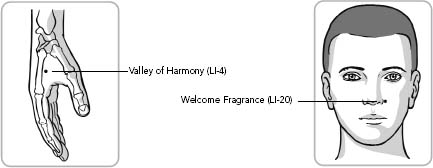
AVOID
• Evening snacks, decrease alcohol consumption, and stop smoking.

• Using antihistamines and sleeping medications, as well as muscle relaxants, as they can loosen the musculature and cause the obstruction of the airways that causes snoring. Consult your physician for alternatives.

• Exposure to substances and circumstances that aggravate the oral and nasal passages, including dusty, dirty, and polluted air.

• Stress, and get plenty of sleep. Sinus congestion is often attributed to lack of sleep and rest, and can contribute to snoring.
SORE THROAT
SORE THROAT, MEDICALLY KNOWN AS PHARYNGITIS, occurs when the tonsils in the pharynx acquire a viral or bacterial infection, creating inflammation and irritation. A sore throat often accompanies or precedes the common cold and flu. Some of the better-known culprits include the adenovirus, mononucleosis, the Epstein-Barr virus, and streptococcus. A sore throat can also be caused by prolonged straining of the vocal cords and throat muscles. Many singers, actors, and people who talk for long periods of time experience sore throats that aren’t related to infections. In some cases, a severe sore throat can cause loss of voice.
Chinese medicine treats sore throat with acupuncture for pain relief and herbal therapy to help the immune system combat infections and heal strained muscles. A sore throat is viewed as a pathogenic heat condition that needs to be cooled, and the pathogens must be expelled. I see many noninfectious cases of sore throat that result from postnasal drip or acid reflux, both of which can be addressed with Chinese medicine. I use topical herbal sprays and solutions of herbs for gargling that soothe the throat muscles and relieve swelling and inflammation, helping patients to quickly recover from the symptoms. Here I offer some advice for sore throat relief. If a sore throat doesn’t clear up within three days and is accompanied by fever, you should see your physician immediately. In rare cases, a potentially dangerous infection of diphtheria can cause sore throat and should be addressed immediately by a physician.
DIET
• Adding more cooling dandelion greens, chrysanthemum flowers, mint, scallions, cabbage, cilantro, burdock root, apples, pears, bitter melon, and rose hips to your diet can help ward off infections and relieve sore throat. Drink plenty of warm or room temperature water, at least eight glasses a day.

• Pear juice is soothing to the throat, as are cucumber juice and honey.

• Avoid foods that are greasy, deep-fried, barbecued, and spicy, as they can irritate the throat. Shellfish should be avoided as well.

HOME REMEDIES
• Slowly swallow 1 tablespoon of honey to coat the throat. Repeat 3 to 6 times a day until the sore throat is gone. The honey works as a natural antibiotic.

• As a throat cleanser, make a solution of 1 part 3 percent hydrogen peroxide and 3 parts warm water, and gargle in the back of your throat for 1 minute twice a day. Do not swallow the solution. This will help disinfect the throat and kill any bacteria or viral infection. A less potent but still effective gargle can be made with sea salt and warm water.

• Cut thin slices of ripe lemons. Add a pinch of salt and eat whole with the peel. This acts as an astringent and kills bacteria.

• Mix 1 tablespoon horseradish, 1 tablespoon honey, and 1 teaspoon ground cloves in a glass of warm water and stir well. Sip slowly to soothe the throat and inhibit the development of microbes.
DAILY SUPPLEMENTS
• Taking vitamin C (1,000 milligrams) 3 times a day can help fight infections.

• Vitamin A (200 IU) or beta-carotene (1,000 milligrams) taken twice a day helps to strengthen immunity.

• Zinc (50 milligrams) lozenges taken every 2 hours at the onset of a colds can reduce duration.
HERBAL THERAPY
• Herbs can be found in health food or vitamin stores, online, and at the offices of Chinese medicine practitioners. Herbs should be used according to individual needs; consult with a licensed practitioner for a customized formulation. To learn more about the herbs listed here, go to www.askdrmao.com.

• Andrographis (king of bitters) 3 times daily can reduce symptoms of colds quickly and inhibit microbe formation.

• Drink chamomile, echinacea and goldenseal tea to support immune function and reduce the frequency and shorten the duration of sore throats.

• Boil 1 teaspoon dried honeysuckle, 1 teaspoon mint leaves, and 1 teaspoon licorice root in 12 ounces of water for 15 minutes, and add 1 teaspoon honey. Strain, and drink as a tea 3 times a day to relieve a sore throat. This is a good remedy for children.

• Traditional Chinese herbs for relieving sore throat and fighting infections include fructus arctii, mulberry leaves, rehmannia, licorice, forsythia, honeysuckle, prunellia, and andrographis.
EXERCISE
Exercise is important for stimulating blood circulation, maintaining a healthy immune system, and preventing colds. I recommend a regimen of daily qi gong and tai chi combined with moderate cardiovascular exercise.
The following is an ancient Taoist vocal qi gong exercise called the Six Healing Sounds meditation. When practiced twice a day it can help relieve sore throat, build strong vocal cords, harmonize the organs, and strengthen the body.
Sit comfortably at the tip of a sturdy chair with your spine erect, your arms placed on your legs, and your head tilted slightly forward.
Begin breathing slowly and rhythmically, inhaling deeply and gently and exhaling slowly through the mouth for 1 minute.
Now begin the practice. You’ll be making 6 different sounds, all soft and quiet, barely audible. You’ll repeat each sound 6 times, for a total of 36 vocalizations.
The first sound is for the liver: a prolonged “shh” (as if quieting a baby). Utter the sound softly and gently on an exhale 6 times.
The second sound is for the heart: a prolonged “ho” (as in “hi ho”). Utter the sound softly and gently on an exhale 6 times.
The third sound is for the spleen and stomach: a prolonged “hoo” (as in “who”). Utter the sound softly and gently on an exhale 6 times.
The fourth sound is for the lungs: a prolonged “sss” (as in “hiss” without the “hi”). Utter the sound softly and gently on an exhale 6 times.
The fifth sound is for the kidneys: a prolonged “foo” (as in “food” without the “d”). Utter the sound softly and gently on an exhale 6 times.
The sixth and final sound is for the gallbladder: a prolonged “shii” (as in “she”). Utter the sound softly and gently on an exhale 6 times.
Conclude the practice with 1 minute of relaxed, rhythmic breathing.
ACUPRESSURE
• Find the acupoint Valley of Harmony (LI-4), at the web between your right thumb and index finger. Apply steady pressure with your left thumb until you feel soreness. Hold for 2 minutes. Repeat on the left hand.

• Locate the acupoint Fish Belly (LU-10), in the fleshy part of your right palm just beneath your thumb. Apply steady pressure with your left thumb until you feel soreness. Hold for 2 minutes. Repeat on the left hand.
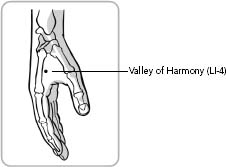
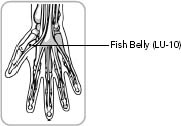
AVOID
• Exposure to dry, dusty, and cold conditions. Use a humidifier in dry climates.

• Alcohol, overeating, eating spicy foods, and smoking, all of which produce heat and can irritate the throat.

• Stress and overexertion, and get plenty of rest and sleep.

• Using old toothbrushes; change them often, or soak them in hydrogen peroxide every other day, as bacteria may collect on the brush.
SUNBURN
THERE IS A FINE LINE BETWEEN A SUNTAN AND A SUNBURN. The skin is very sensitive to ultraviolet rays, and sensitive skin can get a sunburn in less than five minutes of exposure to direct sunlight. Most people think that they can avoid sunburn by staying in the shade, but ultraviolet rays can penetrate the shade. Prolonged and repeated sunburns can cause aging of the skin, loss of skin elasticity, and skin cancer. Symptoms of acute sunburn include itching, blisters, pain, redness, and swelling accompanied by chills, headache, fever, and nausea. Severe sunburn is treated like a first-degree burn and requires the care of a dermatologist.
In Chinese medicine, sunburn is considered a summer heat invasion. The condition resembles the common cold with the additional symptoms of a rash. As the heat from the sun enters the body, it gets trapped in the energy meridians and skin. This trapped heat is often combined with dampness, causing the typical symptoms. I approach sunburn by providing immediate relief with topical herbal therapy along with acupuncture to release the trapped heat from the skin and to soothe the symptoms of burning and pain. I then follow up with oral herbal therapy and dietary advice. The key, of course, is to take precautions to prevent sunburn in the first place.
Here are some good home remedies and recommendations for caring for sunburn.
DIET
• During acute sunburn, overeating is not recommended. Fluids are important to rehydrate the body and skin. Cooling foods including watermelon, cucumber, cantaloupe, honeydew, celery, broccoli, bok choy, lentils, mushrooms, squash, zucchini, pears, peaches, prunes, pineapple, and apples are useful for removing the trapped heat and cooling the body. Drink a glass of water hourly.

• Avoid greasy, barbecued, spicy, and deep-fried foods, as they may worsen the condition. Dairy products in general should be avoided, as they promote the formation of dampness in the body. The exception is yogurt, as the acidophilus in yogurt is helpful for immune function in the healing process. Alcohol and coffee dehydrate the body and produce heat, so they should be avoided.
HOME REMEDIES
• Drink a mixture of 12 ounces each of pineapple and black cherry juice to help reduce inflammation and heat. Drink 3 cups daily.

• Apply a thin layer of plain yogurt to the burn area to cool and soothe the irritation.

• Aloe vera gel applied topically is a tried-and-true remedy for skin burns.

• To prevent sunburn, limit exposure to sun, especially between 10 a.m. and 3 p.m.

• Use a UVA sunscreen with an SPF factor of 30 to 50.

• Wear a long-sleeved shirt, long pants, and a wide-brimmed hat.
DAILY SUPPLEMENTS
• Taking beta-carotene (1,000 milligrams) or other carotenoids (500 milligrams) can prevent severe sun sensitivity.

• Taking fish oils containing omega-3 fatty acids (1,000 milligrams EPA; 800 milligrams DHA) lessen the symptoms of sunburn.

• Vitamins B3 (100 milligrams), C (1,000 milligrams), and E (800 IU) can be taken as a protective measure to prevent sunburn.

• Taking vitamin D (600 IU) supplements helps protect the skin from UVB lights.
HERBAL THERAPY
• Herbs can be found in health food or vitamin stores, online, and at the offices of Chinese medicine practitioners. Herbs should be used according to individual needs; consult with a licensed practitioner for a customized formulation. To learn more about the herbs listed here, go to www.askdrmao.com.

• Green tea and calendula can inhibit cell damage from sunburn. They can be taken internally as a tea or topically as a wash.

• Crush some dandelion greens and apply to the affected area as a poultice, changing every hour. You also can put 1 cup of dandelion greens in a blender and blend with 1/2 cup aloe vera gel and 1 tablespoon honey to make a smoother poultice. Repeat 4 to 6 times a day for maximum relief.

• Traditional Chinese remedies used to treat summer heat syndrome include mung beans, lotus leaf, sweet wormwood, momordica fruit, fermented soy, eupatorium, and elsholtzia.
EXERCISE
Don’t exercise strenuously during a summer heat wave or when you have a bad sunburn. Calm, rest, and relaxation will help with your recovery. I recommend the following general stress-release meditation to calm and relax you while your body heals.
Lie down on your back or sit comfortably with your spine erect at the edge of a chair. If you choose to sit, your feet should be flat on the floor, with your legs bent at a 90-degree angle.
Reach up toward the sky with both hands on a deep inhale. As you hold your breath make tight fists and squeeze, tightening all the muscles in your arms. Slowly exhale, relaxing your arms and bringing your fists down to your chest. Repeat this several times.
Next, cross your arms in front of your chest, with your fingers touching just under your collarbone and your wrists crossed at the center of your upper chest.
Lower your chin toward your chest, and inhale 4 short breaths in a row through your nose (without exhaling). Fill your lungs completely on the fourth breath and hold the breath for a few seconds with the chest full and expanded.
Exhale slowly through your mouth.
Repeat this exercise for 2 or 3 minutes, concentrating on deep and rhythmic breathing.
ACUPRESSURE
• Find the acupoint Valley of Harmony (LI-4), at the web between your thumb and index finger. Apply steady pressure with your left thumb until you feel soreness. Hold for 2 minutes. Repeat on the left hand.

• Locate the acupoint Wind Pond (GB-20), is in the natural indentation at the base of your skull on either side of your neck. Press and lift up toward the base of your skull with your thumbs and lean your head back. Use the weight of your head against your thumbs for steady pressure on the acupoint. Hold for 5 minutes, breathing deeply and slowly.
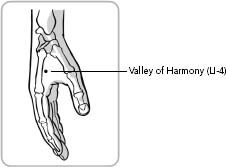
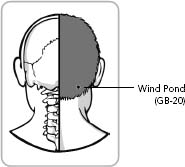
AVOID
• Strenuous activities and outdoor exposure. Rest in a cool but not cold environment.

• Further exposure to the sun or heat, as this may worsen the condition.

• Sun exposure if you’re taking certain drugs that make your skin more susceptible to sunburn, such as tetracycline, thiazide diuretics, anti-anxiety medications such as alprazolam, and NSAIDs such as piroxicam.
TENDINITIS
YOUR SKELETAL STRUCTURE IS HELD IN PLACE by thousands of fibers that form tendons. The tendons attach the muscles to the bones and play a key role in all movements. Tendons and ligaments—which connect one bone to another—can become irritated and inflamed as a result of overuse, repetitive stress, and injury, causing a condition known as tendinitis. Acute tendinitis may develop into a chronic condition if left untreated. The most commonly affected joints include the shoulder (rotator cuff tendinitis), the elbow (tennis elbow or golfer’s elbow), the wrist and thumb, the knee, and the ankles (Achilles tendinitis). Metabolic disorders such as diabetes can cause calcified tendinitis, which occurs when calcium deposits build up in a joint. Symptoms of tendinitis include joint pain that gets worse with movement, swelling accompanied by warmth and redness, tenderness of the limb, and crackling sounds when moving the affected joint. Typical treatment involves anti-inflammatory and pain medication along with physical therapy and rest. In unresponsive cases, an orthopedic physician will most likely recommend cortisone injections to reduce inflammation.
Known as painful obstruction syndrome, tendinitis in Chinese medicine represents blockage of energy and blood flow accompanied by dampness and heat in the affected joint and meridian system. The liver-gallbladder network is responsible for nourishing the tendons and joints of the body, so if this network is weakened as a result of emotional stress or toxic overload, the tendons become malnourished and prone to injury and damage. Tendons have much less blood supply than muscles, so tendon injuries are slower to heal than muscle injuries. I’ve found that tendinitis pain responds very well to acupuncture, as acupuncture can pinpoint where restored blood and energy flow are needed for healing a specific body part. With the addition of herbal therapy, I’ve treated many acute and chronic tendinitis conditions with excellent results. I also work with orthopedists, physical therapists, and other specialists to devise a treatment plan for complete recovery. My approach is to unblock the stagnation, promote the flow of energy and blood, strengthen the liver, and nourish the tendons and ligaments. I also advise my patients on appropriate exercises and lifestyle changes to prevent relapse of the condition.
Here are some of my recommendations.
DIET
• Eat a healthy, well-balanced diet rich in vegetables and fruits, whole grains, and organic animal protein sources. The connective tissue structure also requires calcium and other minerals. Foods high in calcium and vitamin D (needed to enhance calcium absorption) include broccoli, chestnuts, clams, dark green vegetables, flounder, salmon, sardines, shrimp, mussels, and soybeans. Kidney beans, black beans, garlic, onions, kale, tempeh, pineapple, grapes, mulberries, anise seeds, cinnamon, cloves, almonds, walnuts, and prunes are also beneficial for the bones.

• Avoid carbonated soft drinks, alcohol, and smoking. Yeast, sugars, especially processed, bleached sugar, should be eliminated as well. Salt in small quantities can help strengthen the bones but should be used in moderation.
HOME REMEDIES
• For acute tendon or ligament injury, apply an ice pack to the painful area for 15 to 20 minutes 2 to 3 times a day in the first 24 to 48 hours.

• Take hot Epsom salt baths for 20 minutes a day until the pain is substantially decreased.

• Make a natural anti-inflammatory cocktail by mixing equal parts of unsweetened black cherry juice with dark grape juice. Drink 3 to 6 glasses a day until the pain has eased.

• Make a tea with 2 slices of ginger, 1/3 cup chopped parsnip, and 1 teaspoon of cinnamon in 3 1/2 cups of water. Simmer for 15 minutes. Strain, and drink 3 cups a day for 1 month or until condition improves.

• For pain and swelling, crush taro root to make a poultice, and apply to the affected joint, changing every 4 hours.
DAILY SUPPLEMENTS
• The enzyme bromelain (450 milligrams), from pineapple, is a natural anti-inflammatory and helps with muscle and joint pain.

• B complex vitamins and folate are generally diminished with stress and pain, so supplementation can help with the symptoms.

• Glucosamine (1,000 milligrams), chondroitin sulfate (400 milligrams), and MSM (1,000 milligrams) taken together can help support healthy bones and joints.

• Omega-3 fatty acids (1,000 milligrams EPA; 800 milligrams DHA) from fish or flaxseed oil are also naturally anti-inflammatory.
HERBAL THERAPY
• Herbs can be found in health food or vitamin stores, online, and at the offices of Chinese medicine practitioners. Herbs should be used according to individual needs; consult with a licensed practitioner for a customized formulation. To learn more about the herbs listed here, go to www.askdrmao.com.

• A substance in turmeric known as curcumin reduces inflammation.

• White willow bark, licorice, and comfrey are traditionally used for tendinitis and other injuries.

• Traditional Chinese herbs used for tendinitis include angelica root, red peony, eucommia, siler, notoginseng, gastrodia, clematis, corydalis, myrrh, frankincense, rehmannia, and achyranthes.
EXERCISE
There is a definite advantage to exercising regularly. Exercise tones muscles and strengthens joints, and can help prevent tendinitis. Pay special attention to strenuous, repetitive, or jarring movements—especially in active sports—to prevent injury. Never stress the joints beyond their designed flexibility range. And always warm up prior to exercise. Most acute tendinitis cases are caused by not properly warming up before playing strenuous sports. Tai chi and qi gong can help strengthen the body without causing too much stress. The warm-up section of the Eight Treasures Qi Gong helps strengthen the joints and increase flexibility. Practice it twice a day for best results.
In a quiet, comfortable environment, preferably outdoors, stand with your feet shoulder-width apart, knees slightly bent, spine erect, tailbone tucked in, and head tilted slightly forward. Place your arms palms down on your lower abdomen just below the navel, one hand overlapping the other.
Begin with rhythmic, slow, and relaxed breathing. Inhale deeply but softly, and imagine the breath extending all the way down to the lower abdomen, about two finger-widths below the navel. Exhale gently and softly. Stay in this position for 7 breath cycles, relaxing and calming your mind.
Make your right hand into a loose fist and begin tapping your lower abdomen with mild to moderate strength in a rhythmic fashion. Proceed to the middle and upper abdomen, then the chest.
Start tapping under the armpit of the left arm, then the inner part of the arm and down to the palm. Then tap the outer part of the arm back up to the shoulder. Tap the shoulder muscle seven times.
Repeat the same movement with the left hand.
Begin tapping the lower back on both sides with both hands made into loose fists. Move the tapping down the backs of the legs to the outside of the ankles.
Start tapping on the insides of the ankles, working your way up the inside of the calves and thighs.
Finally, return to standing position, again tapping your lower abdomen. End by placing your palms on your lower abdomen, left hand on top of the right. Make clockwise circles, rubbing the lower abdomen 36 times.
ACUPRESSURE
• Find the acupoint Jumping Circle (GB-30), on the center of the buttocks about midway between the tip of the coccyx and the right hipbone. Apply heavy pressure with your thumb or index finger until you feel soreness. Hold for 30 seconds and release. Repeat several times, alternating the left and right sides.
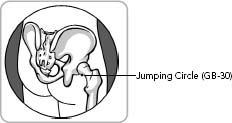
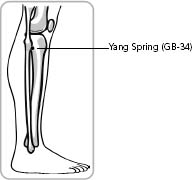

• Find the acupoint Yang Spring (GB-34), on the outer part of the lower right leg, just below the bony structure located near the end of the knee crease, about four finger-widths below the kneecap. Apply steady pressure with your right thumb until you feel soreness. Hold for 3 minutes. Repeat on the left leg.
AVOID
• Smoking, and excessive use of alcohol, as they are irritants, and alcohol especially depletes the liver energy, leaving tendons weak and malnourished.

• Certain medications used for weight loss, such as Xenical (orlistat), as well as minoxidil, which can cause tendinitis. Talk to your doctor about alternatives.

• Repetitive tasks at work or repetitive sports activities. Be mindful of your physical activities and posture and make sure you warm up before exercising.
ULCERS
THAT GNAWING PAIN IN THE STOMACH that sometimes gets better with food and other times gets worse may be from your stomach’s actually digesting itself! This is an ulcer, a condition that affects five million people in the United States today. When the cells protecting the stomach wall from digestive acids fail to work properly, the acids begin to burn away the stomach wall. Ulcers can occur in the stomach or just below the stomach in the part of the small intestine called the duodenum. The symptoms of ulcers vary depending on location but generally include abdominal pain, bloating, fullness, excessive salivation, nausea, vomiting, loss of appetite, and weight loss. You can tell where the ulcer is located based on the pattern of pain—if the ulcer is in the duodenum, the pain gets better after eating but worse an hour later; if it’s in the stomach, the pain gets worse when eating. In severe cases there may be vomiting of blood or passing of a tarlike black stool, which is a result of bleeding from the duodenum. A major cause of ulcers is bacterial infection. The bacteria Helicobacter pylori erode the stomach lining, reducing the protective mucous membrane and stimulating the production of excessive stomach acid. Prolonged use of aspirin and other nonsteroidal anti-inflammatory drugs has also been linked with ulcers, as have smoking, alcohol use, and stress. Antibiotics and acid blocker medications are commonly prescribed for ulcers.
Chinese medicine recognizes that pathogens, diet, and stress play key roles in the development of digestive disorders. Ulcers in particular are viewed as a disharmony between the stomach and liver networks. I see many more conditions of gastroesophageal reflux disorder (GERD)—a precursor condition—than ulcers. The treatment for both conditions focuses on harmonizing the stomach and liver systems, healing the lining of the digestive tract, supporting the functions of digestion, and easing pain and discomfort.
I once had a patient with stomach pain and other symptoms of an ulcer, including a black, tarlike stool. Her gastroenterologist had confirmed the diagnosis with an endoscopy. After three separate courses of antibiotics she was still experiencing pain and an occasional dark bowel movement, and her GI specialist referred her to me. I put her on a treatment program of acupuncture and herbal therapies, and I changed her diet and taught her stress-reduction techniques. Within six weeks, her symptoms disappeared and have not returned.
Here are some of my favorite remedies for ulcers. If you are experiencing severe, doubling-over pain that spreads across the entire abdomen, vomiting with blood, or black, tarlike stools for more than three days, you should consult your physician immediately.
DIET
• The single most important thing you can do to help treat ulcers is to improve your diet. Eating in smaller amounts and more frequently, as well as eating a good breakfast, are essential. According to Chinese medicine, the energy of the stomach network is at it peak between 7:00 and 9:00 a.m., so skipping breakfast robs the stomach of its vital energy source. A high-fiber diet rich in whole grains, legumes, fruits, and vegetables is helpful. Favor alkalinizing foods such as potatoes, cabbage, figs, papaya, kale, spinach, mustard greens, Swiss chard, winter squashes, zucchini, carrots, sweet potatoes, yams, lentils, split peas, and persimmons.

• Do not overeat, skip meals, or eat late at night. Deep-fried and greasy foods stimulate acid and bile production, and should be avoided. Spicy foods, acidic foods, and alcohol are irritants to the stomach lining. Sugar and salt can also act to increase stomach acid and should be minimized. Each person reacts to certain foods differently—there may be particular foods that aggravate ulcers for you, so be watchful of these foods and keep a diary to eliminate foods that are particularly uncomfortable for you. Tomatoes, eggplant, citrus fruits, pineapple, vinegar, and chilies tend to be prime offenders.
HOME REMEDIES
• Cabbage contains several anti-ulcer compounds, so including cabbage in your diet can speed up the healing of ulcers. Try this simple cabbage soup recipe: Combine 2 cups shredded cabbage, 1 cup chopped celery, 1 cup diced potatoes, 1/2 cup okra, 1/2 cup diced onions with 6 cups water and bring to a boil over high heat, then simmer for 30 minutes, or until the vegetables are tender. Season with a pinch of ginger, cumin, and oregano and garnish with cilantro. Eat the cabbage soup 3 to 4 times a week for 1 month, or until the condition improves.

• Make a healing shake with 1 chopped banana, 1/3 cup chopped raw potato, 1/2 cup blueberries, a pinch each of ground cinnamon, cloves, and ginger, and 1 tablespoon honey. Blend in a blender with 1 cup rice milk and 1/2 cup low-fat plain yogurt. Drink with breakfast every morning for 1 month.

• Eat 1 tablespoon of honey on an empty stomach several times throughout the day, keeping the honey in your mouth and allowing it to slowly move down your esophagus. Honey is nature’s antibiotic and has been found to inhibit Helicobacter pylori.
DAILY SUPPLEMENTS
• Supplementing with zinc (50 milligrams), vitamin A (200 IU), and selenium (100 micrograms) can help heal ulcers.

• Taking flavonoid supplements (500 milligrams) can help with the absorption of vitamin C (1,000 milligrams) and support the healing process.

• Quercetin (500 milligrams) taken 3 times a day can help to suppress ulcer formation and also has anticancer properties.
HERBAL THERAPY
• Herbs can be found in health food or vitamin stores, online, and at the offices of Chinese medicine practitioners. Herbs should be used according to individual needs; consult with a licensed practitioner for a customized formulation. To learn more about the herbs listed here, go to www.askdrmao.com.

• A specialized licorice preparation called deglycyrrhized licorice (DGL) taken in chewable form before meals and at bedtime can help relieve ulcer symptoms and help with healing.

• Make a tea by boiling 2 tablespoons dried marigold flowers in 3 1/2 cups of water for 15 minutes. Strain, and drink 1 cup 3 times a day for 2 weeks or until the condition improves. Marigold has traditionally been used to heal ulcers.

• Reishi mushrooms in capsule or tablet form can help the immune system fight inflammation in the stomach.

• Traditional Chinese herbs such as sepia, skullcap, bamboo, and coptidis have antibacterial and acid-neutralizing properties.
EXERCISE
Walking is the best exercise for moving the food along the digestive tract and improving digestion and absorption. The energetic meridians of the digestive organs run along the large muscles of the legs, so walking stimulates energy flow within the channels and promotes digestion. Take an easy 10-minute walk after each meal and massage your abdomen as you walk, making circles around your navel with your palms. This helps move your food through your digestive tract without prolonged accumulation.
A simple walking exercise called Merry-Go-Around Circle Walk is quite helpful for people who can’t exercise vigorously because of a health condition or other prohibiting circumstances.
In a quiet outdoor setting—a park or yard—find a tree with at least 5 feet of clear space around the trunk in all directions. If you were to draw a circle around the tree, its diameter would be around 10 to 12 feet, though larger or smaller circles are fine as well. Perform the exercise for 15 minutes twice a day.
For the first half of the exercise walk clockwise around the tree. For the second half, walk counterclockwise.
With each completed circle change the position of your arms by slightly raising or lowering your hands in front or on the sides of your trunk.
ACUPRESSURE
• Find the acupoint Valley of Harmony (LI-4), at the web between your right thumb and index finger. Apply steady pressure with your left thumb until you feel soreness. Hold for 2 minutes. Repeat on the left hand. This is good for reducing heat and inflammation and opening energy blockages in the GI tract.

• Find the acupoint Inner Gate (P-6), three finger-widths above the wrist crease, between the two tendons on the inside of the left forearm. Apply moderate pressure with your right thumb. Hold for 5 minutes. Repeat on the right arm. This settles the stomach, helps reduce acidity, and calms anxiety.
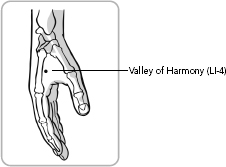
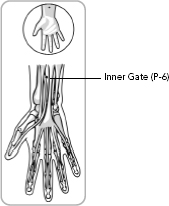
AVOID
• Coffee, alcohol, and smoking; they all can cause or worsen ulcers.

• Excessive use of nonsteroidal anti-inflammatory drugs such as aspirin, which can injure the stomach lining, potentially leading to ulcers. Talk to your doctor about alternatives if you are taking this type of medication.

• Stress, anxiety, and emotional upset before eating and while you’re eating, as this can worse the condition.
VARICOSE VEINS AND SPIDER VEINS
THOSE UNSIGHTLY AND SOMETIMES PAINFUL VEINS that resemble twisted ropes are called varicose veins. A milder form of this condition is known as telangiectasia, or spider veins. Varicose veins are the result of faulty operation of the valves within the veins, which normally help the blood move from the arms and legs back up to the heart. I liken the action of these valves to locks on the Panama Canal—each lock prevents the backflow of seawater, which allows the ship to move from the lower elevation of the Pacific to the higher elevation of the Atlantic Ocean.
When the valves within the veins become defective, blood pools in these areas, enlarging the veins and producing bulging, ropelike features on the skin. With varying degrees of severity, one can experience pain, heavy sensations in the legs that are often worse at night and after exercise, ankle swelling, discoloration around the veins, and the development of dry, itchy, thin areas that can lead to eczema (venous eczema). In the worst cases, the skin is permanently discolored as a result of waste products building up in the legs. More common in women than in men, varicose veins can result from hereditary predisposition, pregnancy, obesity, menopause, aging, prolonged standing, or the prolonged straining that often accompanies chronic constipation.
In Chinese medicine, varicose result from weakness of the muscles and connective tissues, which are governed by the spleen network or the digestive system. With chronic weakness comes the pooling of blood and energy, leading to varicose veins or spider veins. My treatments focus on strengthening the spleen network, supporting healthy digestive function, toning the muscles, and activating the movement of blood and energy. I use acupuncture, acupressure, and massage to stimulate blood circulation, and I target local varicose veins with topical and oral herbal therapy to help reduce swelling and discoloration. I also recommend specific lower-leg exercises to keep the muscles and veins strong.
Here are some of my favorite remedies for varicose veins and spider veins. If you experience severe pain, bleeding, or lumps around the varicose veins you should see a vascular specialist immediately.
DIET
• A high-fiber diet helps prevent constipation, which can build up pressure and aggravate varicose veins. Concentrate your meals around whole grains, legumes, fruits, and vegetables. Citrus fruits (with the rind), apricots, blueberries, blackberries, cherries, rose hips, buckwheat, and millet all contain rutin, a bioflavonoid routinely used to treat varicose veins. Garlic, onions, ginger, and cayenne pepper contain compounds that strengthen the tissues and walls of the veins. Eat plenty of fish, as they are rich in omega-3 fatty acids and can help strengthen the veins and reduce plaque and inflammation.

• Do not overeat. Cut out red meat entirely and restrict fats, refined sugars, and simple carbohydrates. Avoid foods containing preservatives and artificial coloring and flavoring. Salt, alcohol, cheese, and ice cream should be avoided as well.
HOME REMEDIES
• Boil 1 cup of hawthorn berries in 4 cups of water for 20 minutes. Strain, and drink 3 cups a day for 1 month, or until the condition improves. Hawthorn berry can help to tone the cardiovascular system.

• Make tea from 2 tablespoons each of yarrow, horse chestnut, ginger, and prickly ash bark by boiling them in a pot of about 3 1/2 cups of water. Strain, and drink 1 cup 3 times a day for 1 month, or until the condition improves.

• Massaging witch hazel cream twice a day into the affected area can reduce the formation of spider and varicose veins.

• Apply a rag saturated with warmed apple cider vinegar to the varicose veins for 20 minutes twice a day. Follow this treatment with an 8-ounce glass of warm water mixed with apple cider vinegar and 1 teaspoon honey.
DAILY SUPPLEMENTS
• Taking zinc supplements (50 milligrams) can help retain vitamin E (800 IU) in the bloodstream and strengthen the veins.

• Vitamin E supplements (800 IU) can be a preventive against varicose veins.

• Taking vitamin A (400 IU) can help ease varicose ulcerations and speed up healing.

• Taking vitamin C (3,000 milligrams) daily can help strengthen vein walls and prevent dilation.

• Bioflavonoids (800 milligrams) contain properties beneficial for vascular health.
HERBAL THERAPY
• Herbs can be found in health food or vitamin stores, online, and at the offices of Chinese medicine practitioners. Herbs should be used according to individual needs; consult with a licensed practitioner for a customized formulation. To learn more about the herbs listed here, go to www.askdrmao.com.

• Horse chestnut (Semen Aesculus hippocastanum) taken daily can be helpful in reducing varicose veins.

• Butcher’s broom (Ruscus aculeatus) is traditionally used to strengthen loose and bulging veins.

• Traditional Chinese herbs used for varicose and spider veins and to support healthy vascular function include angelica, safflower, peach seed, peony, motherwort, cinnamon, ligusticum, cyathulae root, hare’s ear root, balloon flower root, bitter orange, and licorice.
EXERCISE
Use gravity to reduce the pressure on the veins in your legs. Lie flat on the floor and rest your legs on a chair or straight up against a wall for 5 minutes twice a day to help drain blood from swollen veins. Daily exercise is one of the most effective treatments for strengthening your muscles and vasculature, and swimming is by far the best exercise, as it doesn’t put weight on your legs. If you don’t have access to a pool, use a recumbent stationary bike. Swim or bike for at least 30 minutes a day. Daily stretching exercises upon waking also help.
The following Dao In Qi Gong exercise, Immortal Straightening the Leg, can help strengthen the muscles and promote blood circulation in the legs. Do this exercise for 10 minutes twice a day.
Lie on your back with your legs straight, feet apart, and arms straight and resting naturally alongside your body with your palms up.
Inhale, and bend your left knee, folding your left leg up to your chest.
Clasp your leg with your hands; interlace and lock your fingers. Your body should be relaxed with your head on the floor.
Exhale, and make a circle with your foot at your ankle. Do 5 clockwise circles, then 5 counterclockwise circles.
Inhale, and straighten your knee so your leg is straight up, perpendicular to the floor.
Exhale, and gently and slowly lower your straight leg to the floor, returning to the beginning posture.
Repeat the sequence with your right leg.
ACUPRESSURE
• Find the acupoint Foot Three Miles (ST-36), four finger-widths below the kneecap on the right leg. Apply moderate pressure with your right thumb until you feel soreness. Hold for 5 minutes. Repeat on the left leg.

• Find the acupoint Three Yin Crossing (SP-6), four finger-widths above the inner right anklebone, in the depression near the bone. Apply steady pressure with your right thumb until you feel soreness. Hold for 3 minutes. Repeat on the left leg.
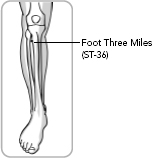
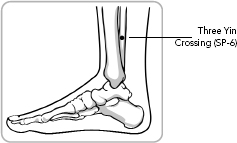
AVOID
• Smoking and alcohol, which are irritants and damage the walls of the blood vessels.

• Prolonged standing or straining. If your job requires you to stand for long periods of time, do the above exercise every hour and stretch your legs at least twice during the day.
WARTS
A COMMON SKIN CONDITION CAUSED by the human papillomavirus (HPV), warts come in a variety of sizes and shapes, and they can occur on the extremities, the face, the genital region, and the soles of the feet. Genital warts are contagious, whereas flat and common warts are not. Mostly harmless and painless, common warts are more of an aesthetic challenge to most people. Those with compromised immune systems, such as people with HIV/AIDS, autoimmune conditions, and those debilitated as a result of severe illnesses, alcohol abuse, and smoking are at an increased risk of getting warts. Hygiene also plays a role—unclean communal baths, showers, and pools are breeding grounds for the HPV virus. Conventional medical treatment involves topical applications of salicylic and lactic acids or surgical removal.
In Chinese medicine, warts are seen as an invasion by a dampness toxin and as a stasis of energy and blood. An underlying weakness in the immune system allows the invasion of pathogens. The best approach is to boost immune function by activating the lung and spleen networks, unblock the stagnation, and expel the pathogenic accumulation. I work with dermatologists to treat children with recurring warts—mainly on their hands and feet—with good success in preventing recurrence. The immunity of children is often inadequately developed, so strengthening immune function is paramount in the prevention and treatment of skin warts. I administer both oral and topical herbal therapy, and dietary and hygiene measures are often part of the treatment. Here are some recommendations I give to my patients.
DIET
• A well-balanced, organic diet is important for maintaining a well-functioning immune system and for nourishing the skin. In many cases of warts (especially flat warts) there is an identified nutritional deficiency of vital substances. Your diet should be based on whole grains, fresh vegetables, nuts and seeds, and organic sources of animal protein. Essential fatty acids obtained from cold-water fish, seeds, and nuts are also important.
• Alcohol consumption increases your risk of getting warts. Caffeine and refined, processed foods, simple sugars, and soft drinks should be eliminated. Dairy and saturated fats and animal fats should be minimized.
HOME REMEDIES
• Apply fresh milky juice from a calendula plant (purchased from a plant nursery) directly on the wart 3 or 4 times a day.

• Aloe vera gel applied directly from the plant to the wart can help remove warts.

• Cut a small square patch from a fresh banana peel. Place it face down on the wart and secure it in place with a bandage or medical tape. Leave it on overnight, changing it every day for 2 to 3 weeks, until the wart is gone.

• Before bed, apply a thin layer of castor oil or olive oil to the affected area, then place slices of garlic on top of the wart and secure it with medical tape or a bandage. Change daily for 2 to 3 weeks, or until the wart is gone.

• Make an immunity broth by cooking 1/2 cup each of broccoli, cauliflower, Brussels sprouts, cabbage, asparagus, and shiitake mushrooms in 6 to 8 cups water and simmer for 1 hour. Add miso to taste. Eat 1 bowl every day until the wart subsides.
DAILY SUPPLEMENTS
• Supplementing with vitamin C (1,000 milligrams), beta-carotene (800 milligrams), vitamin E (800 IU), and zinc (50 milligrams) can help support immune function and facilitate healing. Vitamin E in oil form may be used as topical antiviral.

• Vitamin B complex helps with stress and depression, which can weaken your immune system. Selenium (200 micrograms) also supports the immune function.

• Folic acid (800 micrograms) is recommended for treating genital warts.

• Taking L-lysine (1,000 milligrams), garlic (800 milligrams), and bee propolis (450 milligrams) can reduce viral activity.
HERBAL THERAPY
• Traditional Chinese herbs for warts include brucia seed, tribulus, drynaria, smoked plum, perilla leaf, coix seeds, isatis, angelica, peony, cardamon, apricot seeds, and cork tree bark.

• Other herbs that are antiviral and detoxify include sephora, smilacis, gentian, magnetite, honeysuckle, phellodendri, and safflower.
EXERCISE
The General Cleansing Qi Gong is a meditation practice designed to cleanse the body of toxins and strengthen the immune system. It helps with circulation, promotes movement of qi and blood, and cleanses the skin and channels of pathogens.
Sit comfortably or lie down on your back. Slow your respiration to deep, abdominal breathing. Say the word “calm” in your mind with every exhalation. You’ll be visualizing the relaxation of a body part and releasing tension with every exhalation. Trace the following 3 pathways outlined below.
Start at the top of your head. Inhale, and then exhale and visualize your scalp muscles relaxing. Say “calm” in your mind. Repeat this, saying the word with each body part as you move down through your face, throat, chest, abdomen, thighs, knees, calves, ankles, and feet. When you’ve relaxed your feet, visualize all the tension in your body leaving through your toes in the form of dark smoke.
Next, start at the temple region of your head. This pathway focuses on the sides and upper extremities. Inhale, and then exhale and visualize your temple muscles relaxing. Say the word “calm” in your mind. Repeat this, saying the word with each body part as you move down through your jaw, the sides of your neck, shoulders, upper arms, elbows, forearms, wrists, and hands. Once you’ve relaxed your hands, visualize all the tension leaving your body through your fingertips in the form of dark smoke.
The final pathway begins at the back of your head. This pathway relaxes the back of your body. Repeat the breathing-visualization-word routine, as above, as you go from the back of your neck to your upper back, middle back, lower back, back of thighs, calves, and heels. Then focus on the acupoint Bubbling Spring (KID-1), on the soles of your feet, for 1 minute.
Practice this exercise for at least 15 minutes twice a day.
ACUPRESSURE
• Locate the acupoint Winding Gulch (LI-11), in the depression at the outer part of the right elbow crease, between the elbow tendon and the bone. The point is best located when the arm is bent at 90 degrees with the palm facing the abdomen. Apply steady pressure with your left thumb until you feel soreness. Hold for 3 minutes. Repeat on the left arm.

• Find the acupoint Foot Three Miles (ST-36), four finger-widths below the kneecap on the right leg. Apply moderate pressure with your right thumb until you feel soreness. Hold for 5 minutes. Repeat on the left leg.

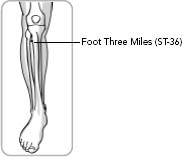
AVOID
• Using public facilities, and practice healthy hygiene. Wash your hands regularly.

• Alcohol and smoking, as they drastically increase your chances of developing warts.

• Stress and avoid emotional extremes.
YEAST INFECTIONS
THE CANDIDA YEAST ORGANISM is a normal part of the intestinal flora—the microorganisms that live in the digestive tract. The balance of the intestinal flora can be disturbed by the use of antibiotics, birth control pills, immunosuppressant drugs, hormones, poor diet, excess stress, alcohol consumption, and other factors. In cases of extreme imbalance, candida flourishes. Initially its overgrowth is limited to the intestines, but it can invade other parts of the body, the most common of which is the vaginal tract. When left untreated, yeast overgrowth produces alcohol and other toxic by-products that put stress on the body. Over 75 percent of women suffer a vaginal yeast infection at least once. The humid, moist, and warm environment of the vagina is very hospitable to yeast. The most common symptom of a yeast infection is a creamy, curdlike discharge accompanied by vaginal itching and burning, painful urination, and pain during intercourse. The condition often gets worse after receiving antibiotic treatments. Conventional medicine typically treats yeast infections with topical or oral antifungal medications.
Chinese medicine classifies candida as an accumulation of dampness and heat toxin in the body. Often a result of a weakened spleen-pancreas-stomach network, digestion is impaired, leading to a buildup of dampness, which tends to permeate the lower parts of the body. The sticky, congealing nature of dampness combined with emotional stress blocks the free flow of energy, generating heat and toxins. The dampness and heat toxin discharge through the vaginal opening, giving rise to the symptoms of candida infection. The relationship between the digestive system and yeast is the key to long-term relief from recurrent yeast infections; this is the case for most of the patients I see for yeast infections. Yeast infections can also result from a weakened immune system, as in chronic fatigue syndrome. My approach to treatment starts with a diet free of ingredients that fuel the growth of yeast, such as refined carbohydrates. I use acupuncture and herbal therapies to support healthy immune function and to inhibit fungal activity and expel dampness and heat toxins.
Below are recommendations I give to my patients.
DIET
• The most important line of defense against candida imbalance, which is almost always the cause of vaginal yeast infections, is proper diet. The diet should be low in carbohydrates—all breads, including wheat and rye breads—should be eliminated, as well as dairy products, cheeses of all kinds, alcohol, sugar, pastries, candy, vinegar, and all pickled foods. Cold and raw foods cause digestive dampness and therefore should be avoided. Leftovers should be frozen, not refrigerated, since mold has a great opportunity to grow overnight.

• Eat more leafy green vegetables, including spinach, collard greens, Swiss chard, mustard greens, dandelion greens, beet tops, carrot tops, as well as barley, garlic, mung beans, citrus fruits, kohlrabi, cabbage, artichokes, and shiitake mushrooms. Fish and nuts should replace red meat and animal fats. Walnut, sesame, flaxseed, olive, and virgin coconut oils are most desirable. Eat little or no fruits, as their sugars fuel the growth of yeast.
HOME REMEDIES
• Make a tea by boiling 1 cup of fresh dandelion in 3 1/2 cups of water for 30 minutes. Strain, and drink 3 cups a day.

• Eat 2 steamed artichokes a day for 1 week, or until the condition clears up. Artichokes have natural antifungal properties.

• Juice 1 bunch beet tops, 1 bunch carrot tops, and 1 large daikon radish. Drink 2 to 3 glasses a day for 1 week, or until the condition subsides.
DAILY SUPPLEMENTS
• Vitamins C (1,000 milligrams) and E (800 IU) and selenium (200 micrograms) act as anti-inflammatory agents and help support immune function.

• Omega-6 (450 milligrams GLA) and omega-3 (1,000 milligrams EPA; 800 milligrams DHA) essential fatty acids are useful as natural anti-inflammatories.

• Probiotics such as acidophilus (3 to 5 billion organisms) are commonly used supplements to control candida overgrowth.

• Taking enteric-coated garlic pills (900 milligrams) can inhibit the growth of candida.

• Taking caprylic acid (500 milligrams) work as an effective antifungal.

• Make sure all vitamins and supplements that you take are yeast free.
HERBAL THERAPY
• Herbs can be found in health food or vitamin stores, online, and at the offices of Chinese medicine practitioners. Herbs should be used according to individual needs; consult with a licensed practitioner for a customized formulation. To learn more about the herbs listed here, go to www.askdrmao.com.

• Chinese herbs that have specific and general antifungal properties include pagoda tree fruit, chaulmoogra seeds, erythrina bark, aloe vera, and genkwa flower.

• Traditional Chinese herbs used to treat yeast infections include gentian root, skullcap, gardenia, akebia, plantain, alisma, bupleurum, rehmannia, angelica, and licorice.

• Herbs to strengthen the spleen-pancreas-stomach network and digestive function include hawthorn, astragalus, codonopsis, atractylodis, tangerine, cardamom, and dioscorea.
EXERCISE
In addition to a regular exercise regimen, I recommend the General Cleansing Qi Gong, which helps with circulation, cleanses the body of toxins, and enhances immune function.
Sit comfortably or lie down on your back. Slow your respiration to deep, abdominal breathing. Say the word “calm” in your mind with every exhalation. You’ll be visualizing the relaxation of a body part and releasing tension with every exhalation. Trace the following 3 pathways outlined below.
Start at the top of your head. Inhale, and then exhale and visualize your scalp muscles relaxing. Say “calm” in your mind. Repeat this, saying the word with each body part as you move down through your face, throat, chest, abdomen, thighs, knees, calves, ankles, and feet. When you’ve relaxed your feet, visualize all the tension in your body leaving through your toes in the form of dark smoke.
Next, start at the temple region of your head. This pathway focuses on the sides and upper extremities. Inhale, and then exhale and visualize your temple muscles relaxing. Say the word “calm” in your mind. Repeat this, saying the word with each body part as you move down through your jaw, the sides of your neck, shoulders, upper arms, elbows, forearms, wrists, and hands. Once you’ve relaxed your hands, visualize all the tension leaving your body through your fingertips in the form of dark smoke.
The final pathway begins at the back of your head. This path relaxes the back of your body. Repeat the breathing-visualization-word routine, as above, as you go from the back of your neck to your upper back, middle back, lower back, back of thighs, calves, and heels. Then focus on the acupoint Bubbling Spring (KID-1), on the soles of your feet, for 1 minute.
Practice this exercise for at least 15 minutes twice a day.
ACUPRESSURE
• Find the acupoint Foot Three Miles (ST-36), four finger-widths below the kneecap on the right leg. Apply moderate pressure with your right thumb until you feel soreness. Hold for 2 minutes. Repeat on the left leg.

• Find the acupoint Abundant Flesh (ST-40), midway between the bottom of the right kneecap and outer anklebone, two finger-widths to the outside of the shinbone. Apply steady pressure with your right thumb until you feel soreness. Hold for 2 minutes. Repeat on the left leg.

• Engaging these points can strengthen digestive function and enhance immunity to prevent candida buildup.
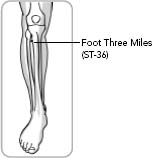
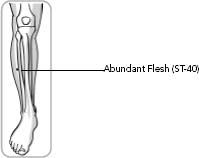
AVOID
• Improper hygiene, to prevent vaginal yeast infections.

• Douches, vaginal deodorants, and long bubble baths taken often, which can change the pH balance of the vaginal canal in favor of yeast overgrowth.

• Broad-spectrum antibiotics, which radically alter balance and can cause yeast overgrowth. Consult your physician.

• Alcohol use and overeating sweets, which also contribute to yeast buildup.